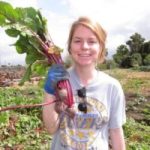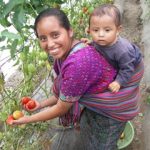Training for Individuals, Communities,
Nonprofits, & Local Governments
Become Adaptable and Resilient
Get road-tested, affordable, do-it-yourself solutions for a changing climate that YOU can launch NOW!
Start today with ‘8 Steps: Cut Your Carbon Footprint 50%.’
Start a Community Garden for Family Food & Nutrition.
Learn how-to start community gardens so at-risk-families can grow nutritious, fresh vegetables.
8 Weeks | Hands-On
How-to launch a program to start community gardens for at-risk families within your community.
The course will lead you through the development of a real community garden project, in real time, and leave you with the practical field tools to build and sustain it.
An 8-week, self-paced training program in launching a community garden project working in partnership with local community members. By the end of the 8 weeks, you will have facilitated a family nutrition workshop and planned, designed and planted a demonstration garden.
If you haven’t worked with urban community gardens before, YOU will learn how to plan, identify resources, build interest, start a community garden project, and plant food.
You will learn about:
Learn by doing. This hands-on training course is for actually launching a community garden project.
In 8 weeks, you will have met with at-risk families to better understand their needs, and their level of interest in urban community gardens. You will have identified land, partners, formed a planning committee and written an achievable plan that incorporates community interests.
You will be designing a community garden and planting food in a demonstration vegetable garden to both teach aspiring gardeners and begin building community interest.
For nonprofits, schools, churches and community groups:
You will receive weekly, step-by-step, hands-on assignments designed to move your project forward.
We will tailor your experience so that you will have the tools and gardening knowledge to teach practical small vegetable garden skills to individuals and families in your community.
Through this program, nonprofits have helped people in North America, Europe, Australia, and Great Britain participate in community gardening programs. The course will lead you through the development of similar, real projects, in real time, in your own community.
Work in a developing nation? If so, this sister course is a better match for you: Village Vegetable Gardens.
Community Gardens course resources include:
The instructor-led course will provide one-on-one instruction in tandem with all of the downloadable course materials listed above. Your instructor will offer professional comments and encouragement for each of your assignments.
Certificate: Upon completing the course and all 6 assignments, you will receive a PDF Certificate of Completion.
This course has a prerequisite: OL 102 Sustainable Development Projects, or OL 242 Funding Your Climate Ready Action Plan, or OL 202 Designing and Funding Non Profit Programs. Why are there prerequisites?
Learn more about this project-based, active learning program in this in-depth description and detailed syllabus.
8 Weeks: Develop a real world project.
Week 1. Overview of Family Food and Nutrition.
Week 2. Develop Survey for Community Members on Food Security & Nutrition.
Week 3. Survey Community Members About Their Food Security & Nutrition.
Week 4. Design a Program for starting a Community Garden.
Week 5. Develop Program Management Tools.
Week 6. Design a Workshop on Community Gardens.
Week 7. Prepare for the Workshop on Vegetable Gardens.
Week 8. Hands-on Workshop: Planting Vegetable Gardens.
Take this course with a live teacher. You will have complete access to the downloadable course resources and lessons described below. This course is offered as a live workshop—perfect for staff or community members. Please contact us for more information.
$100.00
Instructor-Taught Online
Ideal for Community Groups and Nonprofits
8 Week Program
After enrolling, you will be sent a welcome email with login instructions.
Last Step: If you have chosen to work with a live teacher, your next step is to simply fill out the student information sheet to complete your registration.
NGOs: Are you with an international NGO working in developing nations? If so, this sister course is a better match for you: Village Vegetable Gardens.

Mr. Magee also has over 40 years experience with vegetable gardens, specifically with community gardens. He is the author of A Greenhouse Guide to Food Production, and is a Co-Founder of Seattle Tilth: An Urban Agricultural Center.
During the past 20 years, Mr. Magee has worked with 5,000 training participants from nonprofits and NGOs in 154 countries on a wide range of projects and programs about people, the environment, and climate change.
Mr. Magee is available for 1) a live workshop with your group to develop your community garden program or 2) to consult with you one-on-one about your community garden program. Contact us here for more information.
“Genevieve, Martha and I were just reminiscing about your course that we took 10 years ago, and the partnership that has continued to today. Martha has been helping the gardeners, some quite elderly, improve their families’ nutrition for years now. We benefited so much from doing the course together!” Kathy Tate-Bradish.
“You can’t imagine how much the course has helped the group over the years. In fact, many of our households have their on permanent kitchen gardens now.” Martha Muthoni.
“This course inspired me to set up my own home garden where I could experiment before transferring the knowledge to the community. I have been able to test different brands of seeds, try sack gardens, and research methods of rain water harvesting.” Ivy D’Costa.
This course is for nonprofit and donor staff—and job-seekers wanting to successfully solve their community’s challenges sustainably. Participants have worked on projects such as food, nutrition, community gardens, family gardens and inner city food gardens. The course will lead you through the development of similar, real projects, in real time, in your own community.
This course is just as relevant to a person considering a career transition into the nonprofit or development world and wanting to develop employable skills.
8 Weeks: Launch a real community garden project for healthy food.
Assignment timing is flexible.
Week 1. Overview of family food and nutrition.
Week 2. Survey community members about their levels of food security & nutrition.
Free Week. If you need to, this is a good time to catch up.
Week 3. Form a simple planning committee.
Week 4. Draft a step-by-step plan to begin and maintain the process. Incorporate community input.
Week 5. Identify a location and potential partners.
Free Week. If you need to, this is a good time to catch up.
Week 6. Design a workshop on small vegetable gardens in a demonstration local community garden.
Week 7. Prepare for the workshop on the demonstration garden.
Week 8. Lead the hands-on small vegetable garden garden workshop.
How to start your course? Enroll, login, scroll down and click on Welcome Students!
8 Weeks: Launch a real community garden project for healthy food.
Assignment timing is flexible.
Week 1. Overview of family food and nutrition.
Week 2. Survey community members about their levels of food security & nutrition.
Free Week. If you need to, this is a good time to catch up.
Week 3. Form a simple planning committee.
Week 4. Draft a step-by-step plan to begin and maintain the process. Incorporate community input.
Week 5. Identify a location and potential partners.
Free Week. If you need to, this is a good time to catch up.
Week 6. Design a workshop on small vegetable gardens in a demonstration local community garden.
Week 7. Prepare for the workshop on the demonstration garden.
Week 8. Lead the hands-on small vegetable garden garden workshop.
Launching a community garden may not happen overnight. Each of the following steps could take a month or several months. So we’re presenting this course to give you an overview of the process—so that can get started. We suggest that you download and save course resources because in two months you need might be ready for step two or step three.
In a nutshell, you will need to identify like-minded people and form a planning committee. Part of your job will be to clearly determine who the community of gardeners are that would enjoy working in your community garden. You will then need to find a sponsoring organization to support your project. If you already work for a nonprofit then you can save yourself several months and get started rapidly.
You’ll then need to find a location for the community garden. You’ll need to establish guidelines on its use so that as people enroll in hopes of getting a plot they’ll know how to conduct themselves. You’ll then need to plan long-term stewardship so that the community garden can operate indefinitely. You will probably also need to find a funding source because there will be start up expenses and maintenance expenses.
Partnerships are a great way to get started. Potential partners have things like infrastructure (parking, fencing), staff, and insurance. They have experience with and guidelines for working with the general public.
Partnerships can really speed up launching and designing a community garden. Partners can include cities and counties, schools and churches. These organizations also have interest in providing community services.
So let’s get started and look at each one of these steps in greater detail over the next 8 weeks.
I began teaching this course a dozen years ago because I wanted to share my love of vegetable gardening—and to help families be able to enjoy healthy, nutritious food. This is especially important in the developing world, and for low income and inner-city families in the developed world.
I started young. When I was 13, I got a job in a commercial greenhouse and then worked at a botanic garden during high school.
At university, when I got my first little house with a postage stamp garden, I planted my first vegetables. I’ll never forget the magic and the thrill of watching those little seeds turn into mature plants that we could use in our meals.
After University, I began vegetable gardening in earnest in my backyard when this wasn’t a common thing to do in a city! Slowly I met a few other kindred souls. We wanted to spread the word and so we launched an organization called the Tilth Urban Agricultural Center right in the middle of Seattle Washington. It’s been going strong now for 40 years and has grown tremendously—beyond our wildest dreams.
Just for Fun
When I began teaching this series of vegetable gardening courses over 12 years ago, here at the Center for Sustainable Development, I was very excited to share what I knew and my enjoyment with vegetable gardening.
So I wrote this first course description then, in 2010, which might be fun for you to scan because it tells a lot about me, about how I approach vegetable gardening, and the things that I particularly enjoy. There are photos of my garden.
It will also give you an in-depth look at the course that you are about to take. This course is designed to be fun!
Enjoy!
Sincerely, Tim Magee
Please contact us with questions.

How to Grow Vegetables
8 Week Class
Hands On

Urban Container Vegetable Gardens
8 Week Class
Hands On

Nonprofit Care of Food Gardens
8 Week Class
Hands On

Village Vegetable Gardens
8 Week Class
Hands On

Climate Smart Agricultural Program
8 Week Class
Hands On
This is course is the first part of a four-course program on planning, funding, launching, and managing a local climate action plan for your community. The course will lead you through the design and launch of a similar, real project in your local community.
In this first course, you will work hand-in-hand with community members in developing a local climate action plan.
By the end of the 8 weeks, you will have designed a plan complete with climate change solutions that will work for your community’s climate change challenges. Your plan is in preparation for the second course of the program where you will develop a full set of donor documents to present for funding.
Course Syllabus
8 Weeks: Develop a real-life, local climate action plan.
Week 1. Complete enrollment, meet your teacher, and explore the course resources. You will then have the next 3 weeks for Assignment One.
Week 2 & 3. Conduct a climate change conversation with community members to understand their needs, personal interests—and strengths!
Week 4. Clearly define your community and its overall climate challenges.
Week 5. Learn how to solve the challenge using locally-focused climate change solutions.
Week 6. Make sure your plan will work by checking that your climate solutions have success stories that show a proven track record.
Week 7. Assemble a detailed outline for a local climate action plan in preparation for a donor presentation.
Week 8. Share your project with your community and with a donor for feedback.
Where?
Types of communities that you can help prepare for their climate challenges during your participation in this course:
The importance of community members. Every community has different climate challenges: location and size make each community unique. Designing solutions to climate challenges will need to be on a very local, human scale. Top-down plans won’t work.
Consequently, the most important people in designing, launching and maintaining climate action plans are the community members themselves. They know their unique climate challenges, they know potential solutions, and they know what they want for their community. They will become the owners of the plan.
8 Weeks | Course 1 of 4 | Hands-On
This is the first course of four-courses on planning, funding, launching, and managing a climate action plan with your community.
You will work hand-in-hand with community members in developing their plan.
The program is designed to help both experienced—and novice—climate change planners implement bold climate action plans for ensuring that communities are prepared for a changing climate.
Course Objective
In designing a successful climate action plan you will:
Course Outcomes
Learn by doing. This climate change program is for actually launching a climate change action plan with a real community. In 8 weeks you will design a plan complete with solutions for your community’s climate change challenges.
This is in preparation for the second course of the program where you will develop a full set of donor documents to present for funding.
Course participants have helped communities in North America, Europe, Australia, and Great Britain be prepared for local challenges magnified by global warming:
The course will lead you through the design and launch of a similar, real project in your local community.
CSDi’s Climate Solutions Newsletter
Positive, practical news, ideas & actions to combat global warming.
Learn to design solutions for a community’s climate change challenges.
This is course is the first part of a four-course program on planning, funding, launching, and managing a local climate action plan for your community. The course will lead you through the design and launch of a similar, real project in your local community.
In this first course, you will work hand-in-hand with community members in developing a local climate action plan.
By the end of the 8 weeks, you will have designed a plan complete with climate change solutions that will work for your community’s climate change challenges. Your plan is in preparation for the second course of the program where you will develop a full set of donor documents to present for funding.
Course Syllabus
8 Weeks: Develop a real-life, local climate action plan.
Week 1. Complete enrollment, meet your teacher, and explore the course resources. You will then have the next 3 weeks for Assignment One.
Week 2 & 3. Conduct a climate change conversation with community members to understand their needs, personal interests—and strengths!
Week 4. Clearly define your community and its overall climate challenges.
Week 5. Learn how to solve the challenge using locally-focused climate change solutions.
Week 6. Make sure your plan will work by checking that your climate solutions have success stories that show a proven track record.
Week 7. Assemble a detailed outline for a local climate action plan in preparation for a donor presentation.
Week 8. Share your project with your community and with a donor for feedback.
Where?
Types of communities that you can help prepare for their climate challenges during your participation in this course:
The importance of community members. Every community has different climate challenges: location and size make each community unique. Designing solutions to climate challenges will need to be on a very local, human scale. Top-down plans won’t work.
Consequently, the most important people in designing, launching and maintaining climate action plans are the community members themselves. They know their unique climate challenges, they know potential solutions, and they know what they want for their community. They will become the owners of the plan.
8 Weeks | Course 1 of 4 | Hands-On
This is the first course of four-courses on planning, funding, launching, and managing a climate action plan with your community.
You will work hand-in-hand with community members in developing their plan.
The program is designed to help both experienced—and novice—climate change planners implement bold climate action plans for ensuring that communities are prepared for a changing climate.
Course Objective
In designing a successful climate action plan you will:
Course Outcomes
Learn by doing. This climate change program is for actually launching a climate change action plan with a real community. In 8 weeks you will design a plan complete with solutions for your community’s climate change challenges.
This is in preparation for the second course of the program where you will develop a full set of donor documents to present for funding.
Course participants have helped communities in North America, Europe, Australia, and Great Britain be prepared for local challenges magnified by global warming:
The course will lead you through the design and launch of a similar, real project in your local community.